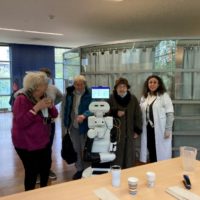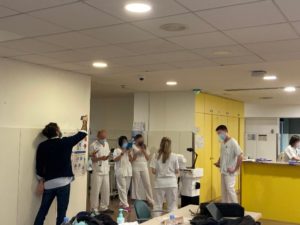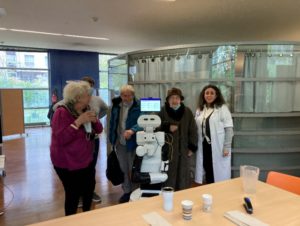
SANDRo completed
HIT & PAL completed DIH HERO project SANDRo. Robot Rose is based on the Tiago Platform.
Over the last year Heemskerk Innovative Technology BV (HIT), together with PAL Robotics, worked on the SANDRo (Semi-Autonomous Day & Night Robot) project, which was funded by DIH Hero.
Thanks to the SANDRo project we were able to form the basis of our multi-purpose service Robot Rose. The outcome of the project is a complete package of hardware and software capabilities for Robot Rose, which was demonstrated in real settings and achieved TRL7.
We performed trials in care organizations in three different countries:
- El Carme Sociosanitary centre in Badalona (Spain)
- Broca Living Lab/ Broca Hospital in Paris (France)
- De Zorggroep in Venlo (Netherlands)
We performed trials in care organizations in three different countries (El Carme Sociosanitary centre in Badalona (Spain), Broca Living Lab/ Broca Hospital in Paris (France) and De Zorggroep in Venlo (Netherlands)).
Via the trials we managed to:
- complete the core functionality of our service robot towards version A
- validate in real settings and reach TRL7
- prove the potential value of Rose in different care systems across Europe
- establish strong contacts and partnerships with potential customers
- earn valuable feedback on the functionality, user acceptance and necessary improvements towards commercialization
In more detail the trials consisted of the following series:
El Carme Sociosanitary centre in Badalona (Barcelona) in Spain, 14-18 March 2022
In these trials we performed a mix of autonomous and remotely controlled tasks.
These included:

- Security task: autonomous patrolling and checking alert lights of the rooms of the hospital orthogeriatric ward. When an alert light is triggered (red), a notification with the room number and alert time is sent to the tablet/smartphone of the responsible nurse.
- Monitor patient status: autonomous patrolling, checking of door status (open/close) of patients’ rooms according to an open doors protocol for safety and sending notifications if a door is closed (with the room number and time). In case of open doors, the robot entered the room and checked if a patient has fallen on the floor from his/her bed. In case of fall an alerting notification was sent to the nurse’s tablet with the room number and time of the fall detection.
- Remote care activities: This task concerned several activities that the robot could perform via its tablet interface, speech recognition and voice in order to provide remote services to patients. These services included web calls with a caregiver or a family member, activation and entertainment, by showing a video with exercises and motivate people to do them or by playing music (selection from a list of songs), cognitive exercises and question-and-answers games performed by a social worker or therapist via the robot’s text-to-speech and speech-to-text modules. These activities were triggered both by the patients via verbal commands and using the robot’s autonomous dialog module, as well as initiated by a care worker remotely via a dedicated tablet app.
Broca Living Lab (within Broca Hospital) in Paris, France, 28 March – 01 April 2022
These trials, focused more on the human-robot interaction and included the following use cases:
- Use Case 1: Admission Routine of patients: The robot welcomes the patients at the entrance of the BLL facility. It explains them the safety and sanitary regulations & guidelines. Afterwards the robot checks if the participants wear their mask properly and prompts a warning message accordingly. Consequently, it asks if they would like to drink something or go to the toilet before the session starts. Depending on the answer of the participant, the robot guides them either to the kitchen or to the toilet at the back side of the facility. Finally, when the participant is ready, the robot escorts him/her to the trials location (same as the kitchen).
- Use Case 2: Patrolling and monitoring for fallen persons: The robot patrols in the facility (the BLL facility has a round room in the middle so the robot patrolled around this room), while a care professional/researcher can monitor the are via the robot’s eyes, through the tablet application. At some point a person has fallen on the floor and once the robot sees him gives a verbal warning. During patrolling, the participant waves to the robot, and then the robot approaches him/her to start the interaction session.
- Use Case 3: Response to regular day-to-day requests: This use case concerned the demonstration of teleoperation, during which the robot performs a number of tasks asked by the participant, such as hand over of objects and pick up from the floor.
- Use Case 4: Support for therapeutic or occupational activities: The robot is used as an activation/motivation companion, used to stimulate the geriatric patients, according to the program defined by the care professionals. The robot has some simple interactions with the patient, presenting the activities and motivating the participation in the session. The task can be either autonomous or nurse initiated (controlling the robot via the tablet. The robot included the following activities: remote webcall, play music, play a video, read news from a website and chit-chat discussions (in a Wizard of Oz setting). For each of the above activities there was a number of options (songs, videos, newspapers) which the participants could choose from.
De Zorggroep in Venlo, Nederland, 11-14 April 2022
These trials had the form of a demonstration combined with interactive sessions and included the following use cases: 
- Use Case 1: Admission routine for attendees The robot welcomes a person at the entrance of the trial building. The robot autonomously detects the person and in case detected asked if the person is there for the trial. If the answer is yes, the robot autonomously interprets the answer and, consequently, escorts the attendee to an empty seat in the audience.
- Use Case 2: Navigation The navigated among static obstacles and walking humans who blocked the planned navigation path of the robot.
- Use Case 3: Informant and overcome waiting time A scenario was demonstrated where two clients were in two separate “rooms” in the location. Both of the “clients” needed help at the same time, but one of them had a higher urgency. A care worker could send the robot to the client with the least urgency with one press of a button on the tablet user interface. The robot initiated a dialogue upon arrival, informing the client that the care worker will be there in 5 minutes. The robot offered the waiting client a video or some music to bridge the waiting time.
Furthermore, we demonstrated fall detection, remote control (teleoperation), and performed an interactive post-trial evaluation with the participants, on the robot’s functionality and future use in De Zorggroep’s premises.
The SANDRo project has been a big milestone for HIT in the development of Rose and towards its deployment in the healthcare sector.
Official website
Click here to visit the official website of Robot Rose
